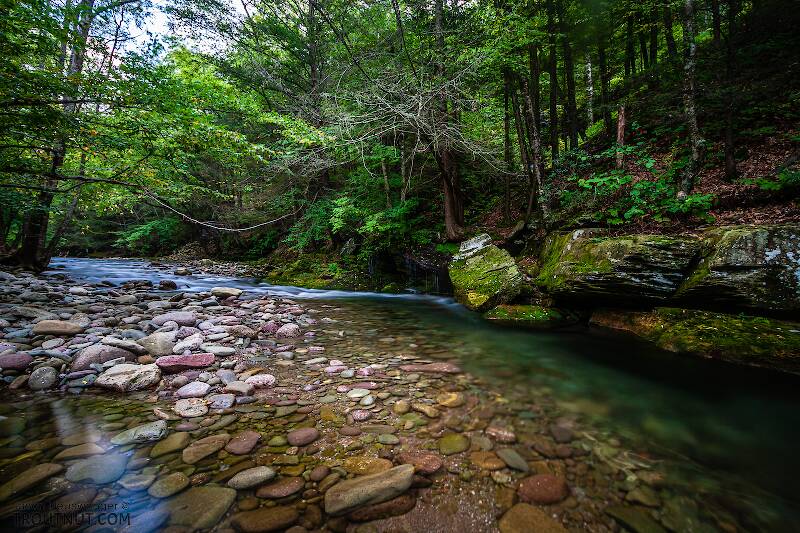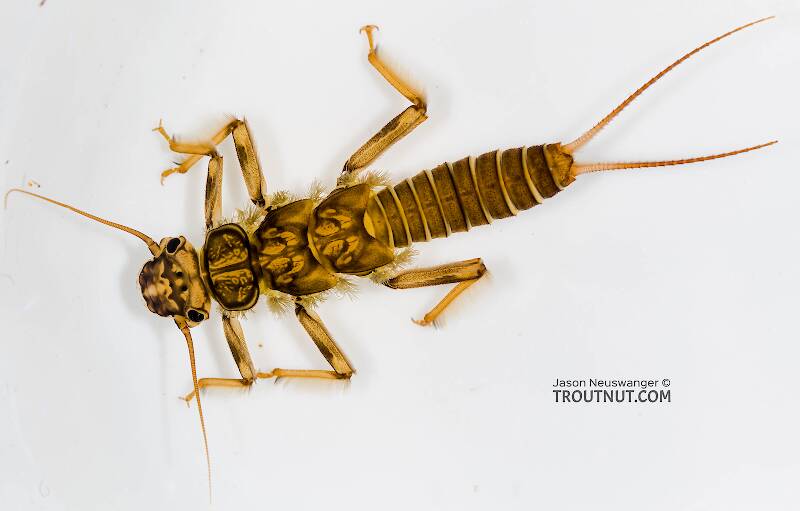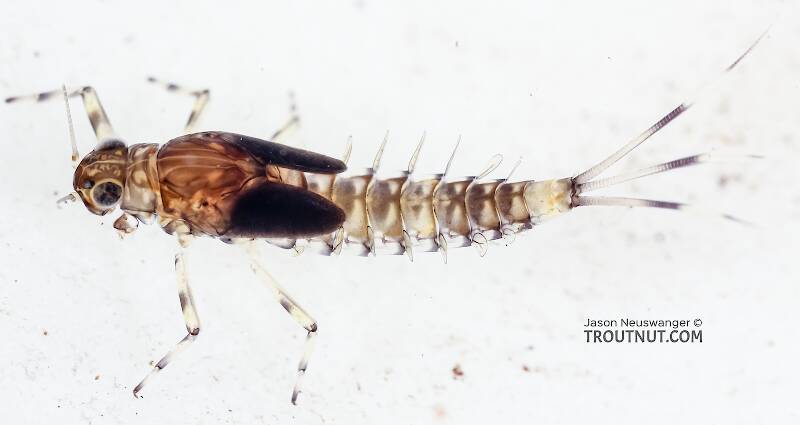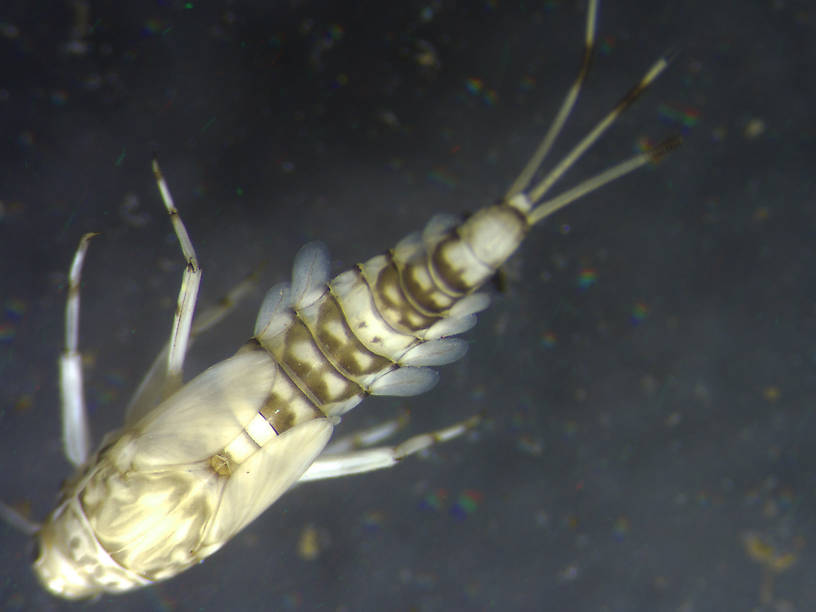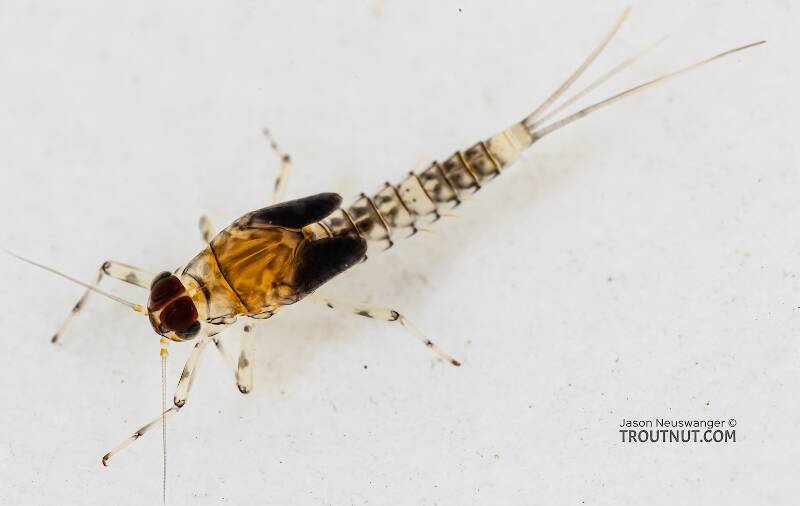
Hex Mayflies
Hexagenia limbata
The famous nocturnal Hex hatch of the Midwest (and a few other lucky locations) stirs to the surface mythically large brown trout that only touch streamers for the rest of the year.

Mayfly Species Baetis flavistriga (BWOs)
This species is known in angling books by several old synonyms, including Baetis quebecensus, Baetis levitans, Baetis cingulatus, and Baetis phoebus, in addition to the correct name.
Where & when
The first flies of this species make their appearance a few weeks after Baetis tricaudatus. Because the species is a combination of widely varying types in different places, it's hard to piece the information together into reliable hatch dates for the different broods in any given location. The best hatches for which this species is credited occur in June.In 57 records from GBIF, adults of this species have mostly been collected during June (33%), July (32%), May (14%), and August (12%).
In 57 records from GBIF, this species has been collected at elevations ranging from 512 to 8005 ft, with an average (median) of 5269 ft.
Species Range
Nymph biology
Current speed: Any; best in fast
Substrate: Gravel
Physical description
Most physical descriptions on Troutnut are direct or slightly edited quotes from the original scientific sources describing or updating the species, although there may be errors in copying them to this website. Such descriptions aren't always definitive, because species often turn out to be more variable than the original describers observed. In some cases, only a single specimen was described! However, they are useful starting points.
Male Spinner
Wing length: 4-5 mm
Abdominal tergites 2-6 of male imago hyaline, tinged with yellowish brown; genitalia of the Baetis intercalaris type, the tubercle on the inner apical margin of the first forceps joint well developed.
Turbinate eyes small, oval, light brown with a yellowish tinge; stalk long, purplish brown, the upper third yellow. Face black; pale green markings around base of antennae and ocelli; antennae blackish. Thorax dark olivaceous; yellowish shading on the pronotum; an oblique yellow streak runs forward from the wing roots along the lateral margin of the mesonotum. Pleural sutures with yellow markings. Legs dirty whitish, femora pale yellow. Wings hyaline; venation pale. Intercalaries of the fore wing shorter than in B. intercalaris, particularly those of the first pair. Hind wing as in B. nanus (now a synonym of Baetis flavistriga).
Abdominal tergites 2-6 hyaline, tinged with pale yellowish brown; 7-10 light umber brown. The contrast between the basal and apical tergites is less marked than in Baetis phoebus and B. intercalaris. Sternites paler, the apical ones opaque. Slight black markings on the spiracular area. The tubercle on the first forceps joint well developed. This species has been separated from the closely allied B. nanus by the color of the eyes in living insects, the darker thorax, and the browner basal abdominal tergites.
Described as B. levitans
Body length 4 mm, wing length 4.5 mm
Abdominal tergites 2-6 of male imago pale yellowish white, with faint posterior and lateral brown shading; genitalia of the Baetis intercalaris type, the tubercle on the inner apical margin of the first joint scarcely or not at all developed (see fig. 164).
Turbinate eyes moderate in size; deep ruddy brown in color. Face and antennae black-brown. Thorax deep olive brown; lateral margins of the mesonotum, before the wing roots, often yellowish; scutellum dark, but a central and two lateral yellowish patches just anterior to it. Anterior projection of the metanotum whitish. Ruddy shading on the pleura, the sutures yellowish in part. Legs pale yellow. Femora more or less shaded with brown, which is continuous over the entire length of the fore femur, reduced to a median and an apical spot on the middle femur, and on the hind one to an apical spot only. Wings hyaline, venation pale. First and second pairs of intercalaries of the fore wing rather short, frequently broken; the next two pairs longer. Hind wing more than two and one-half times as long as its width; narrower than in B. cingulatus (now a synonym of Baetis phoebus), and more or less even in width throughout. Third vein well developed, running close to the hind margin. One intercalary may be present between the 2nd and 3rd vein.
Abdominal segments 2-6 pale whitish yellow, semi-translucent, the tergites shaded laterally and posteriorly with pale brown. Tergites 7-10 light russet brown; sternites opaque, creamy, with faint tinges of brown. Tracheae along the spiracular area strongly black, forming a wavy double black line with dorsal and ventral branches extending from it. This species has larger eyes than B. flavistriga, which has quite similar abdominal markings. The lack of the tubercle on the first forceps joint, the smaller eyes and darker scutellum, separate it from B. cingulatus.
Described as B. nanus
Body length 3 mm, wing length 4 mm
Abdominal tergites 2-6 of male imago yellowish, semi-hyaline; genitalia of the Baetis intercalaris group, the tubercle on the inner apical margin of the first forceps joint well developed.
Turbinate eyes small, oval (smaller than in B. flavistriga); pale yellowish brown in living specimens, bright red with yellow around the rims, in dried ones. Thorax pale olivaceous; the posterior portions may be tinged with smoky; anterior sutures shaded with brownish. Legs dull hyaline whitish, except the fore femora, which are yellow. Wings hyaline, venation pale. Third vein of hind wing well developed, extending to or beyond the middle of the hind margin. Between veins 2 and 3, traces of an intercalary are often present.
Abdominal tergites 2-6 semi-hyaline, yellowish, sometimes tinged faintly with brown; 7-10 opaque, Isabella brown in color. Sternites pale dull ochreous, the lateral areas noticeably hyaline. Tracheae and spiracular line with streaks and dots of blackish. Genitalia of the intercalaris type. Tails whitish.
Specimens of the Mayfly Species Baetis flavistriga
3 Nymphs
Discussions of Baetis flavistriga
pleased to report the emergence of a new baetis flavistriga which i have christened computatii
forum visitors using the Firefox browser who put troutnut.com on their bookmarks toolbar have undoubtedly noticed a tiny dark mayfly icon in a blue box next the bookmark.
well, it's breeding. came back this evening from a week out of town to discover that the little troutnut computatii had a pal over next the hotmail.com bookmark where formerly there was only a generic white icon. am waiting for it to show up next the other two sites that have only generic icons.
now our resident boffins will help me with the Latin ending on the new name, (i tried to use the genitive plural) and then we'll ask Jason how he got these virtual flies to multiply.
Casey
Jason says that B. flavistriga is a "combination of widely varying types in different places, it's hard to piece the information together into reliable hatch dates for the different broods in any given location." This is stated very well.
As part of my bug work, I'm trying to tease apart some of these "varying types" to see what, if anything, they might represent. Tapping into the experience base here might help.
Start a Discussion of Baetis flavistriga
References
- Arbona, Fred Jr. 1989. Mayflies, the Angler, and the Trout. Nick Lyons Books.
- Caucci, Al and Nastasi, Bob. 2004. Hatches II. The Lyons Press.
- Knopp, Malcolm and Robert Cormier. 1997. Mayflies: An Angler's Study of Trout Water Ephemeroptera . The Lyons Press.
- Leonard, Justin W. and Fannie A. Leonard. 1962. Mayflies of Michigan Trout Streams. Cranbrook Institute of Science.
- Needham, James G., Jay R. Traver, and Yin-Chi Hsu. 1935. The Biology of Mayflies. Comstock Publishing Company, Inc.
- Swisher, Doug and Carl Richards. 2000. Selective Trout. The Lyons Press.
Mayfly Species Baetis flavistriga (BWOs)
Species Range
Common Names
Resources
- NatureServe
- Integrated Taxonomic Information System
- Global Biodiversity Information Facility
- Described by McDunnough (1921)

